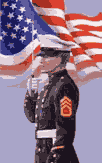The History of
The Marines' Hymn

|
The History of |
|
|
|
|
Following the
war with the Barbary Pirates in 1805, when Lieutenant P.N. O'Bannon and his
small force of Marines participated in the capture of Derne and hoisted the
American flag for the first time over a fortress of the Old World, the
Colors of the Corps was inscribed with the words: "To the Shores of
Tripoli." After the Marines had participated in the capture and occupation
of Mexico City and the Castle of Chapultepec, otherwise known as the "Halls
of Montezuma," the words on the Colors were changed to read: "From the
Shores of Tripoli to the Halls of Montezuma." |
|
Following the close of the
Mexican War came the first verse of the Marines' Hymn, written,
according to tradition, by a Marine on duty in Mexico. For the sake of
euphony, the unknown author transposed the phrases in the motto on the
Colors so that the first two lines of the Hymn would read: "From the
Halls of Montezuma, To the Shores of Tripoli." |
A serious attempt to trace the tune of the Marines'
Hymn to its source is revealed in correspondence between Colonel A.S.
McLemore, USMC, and Walter F. Smith, second leader of the Marine Band.
Colonel McLemore wrote: |
"Major Richard Wallach, USMC, says that in 1878, when
he was in Paris, France, the aria to which the Marines' Hymn is now sung was
a very popular one." The name of the opera and a part of the chorus was
secured from Major Wallach and forwarded to Mr. Smith, who replied: "Major
Wallach is to be congratulated upon a wonderfully accurate musical memory,
for the aria of the Marine Hymn is certainly to be found in the opera,
'Genevieve de Brabant'...The melody is not in the exact form of the Marine
Hymn, but is undoubtedly the aria from which it was taken. I am informed,
however, by one of the members of the band, who has a Spanish wife, that the
aria was one familiar to her childhood and it may, therefore, be a Spanish
folk song." |
|
In a letter to Major Harold F.
Wingman, USMC, dated 18 July [1919], John Philip Sousa wrote: "The melody of
the 'Halls of Montezuma' is taken from Offenbach's comic opera, 'Genevieve
de Brabant' and is sung by two gendarmes." Most people believe that the aria
of the Marines' Hymn was, in fact, taken from "Genevieve de Brabant," an
opera-bouffe (a farcical form of opera, generally termed musical comedy)
composed by Jacques Offenbach (1819-1880), and presented at the Theatre de
Bouffes Parisiens, Paris, on November 19, 1859. |
|
Offenbach was born in Cologne,
Germany, June 20, 1819 and died October 5, 1880. He studied music from an
early age and in 1838 entered the Paris Conservatoire as a student. In 1834
he was admitted as a violoncellist to the Opera Comique and soon attained
much popularity with Parisien audiences. He became conductor of the Theatre
Francais in 1847 and subsequently leased the Theatre Comte, which he
reopened as the Bouffes-Parisiens. Most of his operas are classed as comic
(light and fanciful) and include numerous popular productions, many of which
still hold a high place in European and American countries. |
Genevieve de Brabant was the wife of Count Siegfried
of Brabant. Brabant, a district in the central lowlands of Holland and
Belgium, formerly constituted an independent duchy. The southern portions
were inhabited by Walloons, a class of people now occupying the southeastern
part of Belgium, especially the provinces of Liege, Arlon and Namur. |
|
Every campaign the Marines have taken part in gives birth to an unofficial verse. For example, the following from Iceland: "Again in
nineteen forty-one |
|
Copyright ownership of the Marines' Hymn was vested in the United States Marine Corps per certificate of registration dated August 19, 1891 but is now in the public domain. In 1929, the Commandant of the Marine Corps authorized the following verses of the Marines' Hymn as the official version: "From the Halls
of Montezuma |
On November 21,
1942, the Commandant of the Marine Corps approved a change in the words of
the fourth line, first verse, to read, "In air, on land, and sea." |
|
Former-Gunnery
Sergeant H. L. Tallman, veteran observer in Marine Corps Aviation who
participated in many combat missions with Marine Corps Aviation over the
Western Front in World War I, first proposed the change at a meeting of the
First Marine Aviation Force Veterans Association in Cincinnati, Ohio. |
|
Many interesting
stories have been associated with the Marines' Hymn. One of the best was
published in the Stars and Stripes, the official newspaper of the AEF, under
date of August 16, 1918. |
|
"A wounded officer
from among the gallant French lancers had just been carried into a Yankee
field hospital to have his dressing changed. He was full of compliments and
curiosity about the dashing contingent that fought at his regiment's left. |
|
"'A lot of them are
mounted troops by this time,' he explained, 'for when our men would be shot
from their horses, these youngsters would give one running jump and gallop
ahead as cavalry. I believe they are soldiers from Montezuma. At least, when
they advanced this morning, they were all singing "From the Halls of
Montezuma to the Shores of Tripoli".'" |
|
The Marines' Hymn has
been sung and played in all of the four corners of the earth and today is
recognized as one of the foremost service songs. |
|
Send e-mail to the Web Sergeant |